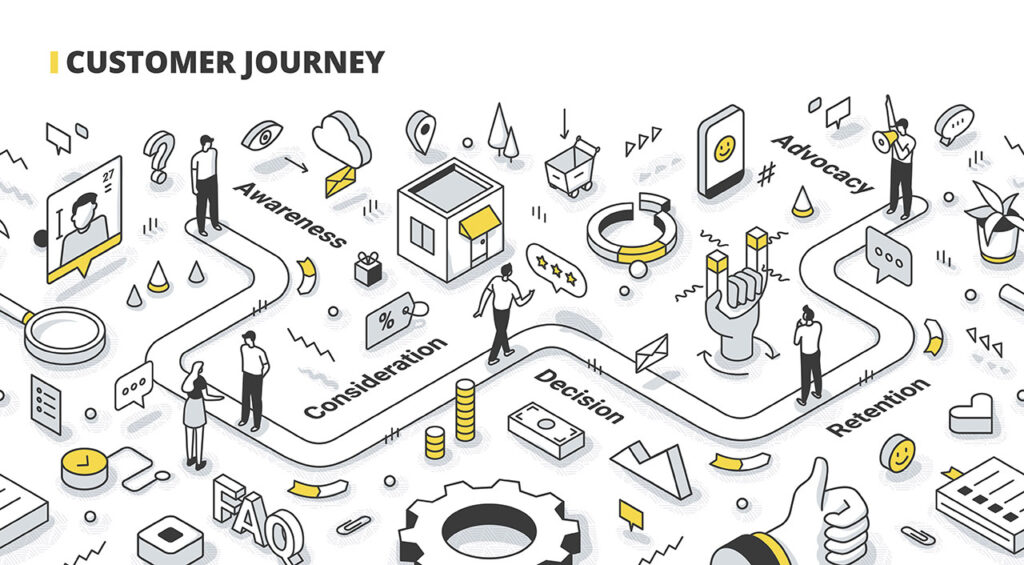Method 1: Create a customer journey map
The customer journey map is a powerful tool for understanding the entire customer journey.

It not only provides a visual representation of the different stages, but also highlights the key moments when the customer comes into contact with the product or service.
By mapping the customer journey in detail, we can not only identify potential challenges and weaknesses, but also recognize opportunities for improvement and innovative approaches.
The journey begins with the discovery of the product, where the first impression is made, and continues through the purchase decision to the use of the product.
But even after the purchase, the customer journey is not complete – customer service and possible follow-up interactions play a crucial role in customer loyalty.
By understanding the customer journey, companies can target the various touchpoints in order to continuously optimize the customer experience.
It offers a holistic perspective that is not just focused on isolated transactions, but takes the entire customer lifecycle into account.
A well thought-out customer journey map is therefore not only a tool for analysis, but also a basis for strategic decisions to increase customer satisfaction and long-term customer loyalty.
Summary: • Create a customer journey map to visualize the entire experience from the customer's perspective. • Identify all points of interaction, from product discovery to post-purchase customer service.
Method 2: Collecting feedback via surveys
Conducting regular customer surveys is an essential part of our commitment to delivering outstanding customer experiences.
These surveys not only serve to take the pulse of customer satisfaction, but also provide a valuable opportunity to gain direct insight into the various stages of the customer journey.
To gather truly meaningful feedback, the wording of the questions is crucial.
Use precise and specific questions to not only get general assessments, but to delve deeper into customer perceptions.
For example, ask about specific experiences with product quality, customer service or the user-friendliness of the website.

The insights gained from these surveys not only offer the opportunity to consolidate existing strengths, but also to identify and specifically address potential weaknesses.
Customer orientation means not only reacting to events that have already occurred, but also proactively responding to the needs and expectations of our customers.
By combining direct customer feedback and a comprehensive customer journey analysis, we create a solid foundation for continuous improvement and adapting our strategies to meet the changing needs of our customers.
Summary: • Conduct regular surveys to get feedback directly from customers at various stages of their experience. • Use specific questions to gain insight into perceptions of product quality, customer service, website navigation, etc.
Method 3: Analyze customer reviews
Monitoring online review platforms, social media and customer reviews is an essential part of developing a deep understanding of our customers’ perspective.
These platforms provide a direct insight into the authentic opinions and experiences of our customers.

Not only is it important to acknowledge the positive feedback, but analyzing critical reviews is just as crucial.
By looking closely at both praise and constructive criticism, we can not only confirm our outstanding performance, but also identify potential weaknesses that need to be overcome.
Positive reviews serve as confirmation of successful aspects of our products or services. They not only provide motivation, but also act as points of reference for areas that are particularly appreciated.
On the other hand, negative reviews enable us to identify specific weaknesses and initiate targeted measures for improvement.
This continuous monitoring and analysis of customer feedback on various platforms enables us to respond to our customers’ needs in an agile manner and ensure the continuous optimization of our products and services.
By taking this holistic approach, we not only create a basis for customer satisfaction, but also for long-term customer loyalty and a positive brand reputation.
Summary: • Monitor online review platforms, social media and customer reviews to gather direct customer feedback. • Analyze both positive and negative reviews to identify strengths and weaknesses.
Method 4: Use metrics in customer service
Analyzing customer service metrics is a key component of our efforts to ensure excellent customer service.
By gaining a deeper understanding of response time, resolution rate and customer satisfaction ratings, we gain not only quantitative data, but also qualitative insights into the effectiveness of our service processes.
The response time, measured from request to response, reflects the speed with which we respond to customer needs.
A high resolution rate provides information on how effectively we can solve problems.
Customer satisfaction ratings, in turn, provide direct feedback on how our customers perceive the quality of service they receive.
In addition, it is particularly important to recognize patterns in customer inquiries.
By identifying recurring issues, we can develop targeted solutions to address frequently occurring problems efficiently and proactively.
This not only enables concerns to be resolved quickly, but also shows our customers that their needs are being taken seriously and understood.
The ongoing optimization of customer service based on such analyses helps to continuously improve service quality and promote a customer-oriented corporate culture.
In this way, we not only create positive service experiences, but also strengthen our customers’ loyalty to our brand in the long term.
Summary: • Analyze customer service metrics such as response time, resolution rate and customer satisfaction ratings. • Identify patterns in customer inquiries and create solutions for common problems.
Method 5: Research online behavior
In the era of digital transformation, the analysis of online behavior plays a crucial role in researching and improving the customer experience.
The use of powerful web analytics tools enables companies to go far beyond superficial data and gain in-depth insights into the behavior of their online customers.
By precisely evaluating page views, you can not only identify popular areas of the website, but also determine which content resonates most with visitors.
The length of time spent on certain pages in turn provides information on how effectively the content is tailored to the target group.

At the same time, abandonment rates make it possible to identify weak points where visitors drop out of the interaction.
For example, there could be unclear call-to-action elements or obstructive usability aspects.
Optimizing the online experience based on such insights leads to a more intuitive, smooth navigation and contributes significantly to customers successfully achieving their goals on the website.
This not only increases customer satisfaction, but also lays the foundation for a sustainable digital presence.
Summary: • Use web analytics tools to track customers' online behavior. • Analyze data on page views, dwell time and abandonment rates to identify weak points in the online experience.
Method 6: Conduct usability tests
Immerse yourself in the world of usability by using carefully conducted usability tests to comprehensively evaluate how users interact with websites, apps or other digital platforms.

These tests not only provide a clear insight into the user experience, but also serve to identify potential hurdles that could affect customer interaction within the customer experience (CX).
The insights gained enable an in-depth analysis of the functionalities of your digital presence.

presence. By precisely identifying potential obstacles, you can work specifically on improving user-friendliness. This ensures that customer interaction is not only smooth, but also positive and effective.
Special attention should not only be paid to the positive aspects, but also to the targeted identification of potential weaknesses.

This approach makes it possible to continuously optimize the customer experience and ensure that every interaction with your digital platforms is an outstanding experience for users.
Summary: • Conduct usability tests to evaluate the user-friendliness of websites, apps or other digital platforms. • Identify potential hurdles that could affect customer interaction.
Method 7: Use mystery shopping
Establish mystery shopping as an effective tool in which trained people act as mystery shoppers to evaluate the quality of customer service and compliance with company guidelines.

Examine the extent to which employees are not only trained superficially, but also comprehensively, and analyze the coherence of customer interactions.
The focus here is not only on external appearances, but also on the depth of the training.
Evaluate how effectively the acquired skills are put into practice and to what extent they contribute to a smooth and positive customer experience.
It is critical to not only superficially review compliance with company policies, but also to ensure that these policies are consistently adhered to in actual interactions with customers.
This comprehensive assessment of service quality not only uncovers potential opportunities for improvement in training and implementation, but also provides a solid basis for objective evaluation.
The implementation of mystery shopping not only provides an objective basis for evaluation, but also provides valuable insights that contribute to the continuous optimization of customer service.
Summary: • Conduct mystery shopping to check the quality of customer service and compliance with company policies. • Evaluate how well employees are trained and how consistent customer interactions are.
Method 8: Benchmark against industry standards
Using a comparison between your own customer experience (CX) and industry standards not only opens up the possibility of an objective assessment, but also offers the opportunity to identify specific areas in which your company particularly stands out.
Through careful comparison with best practices, inspiring success patterns can be identified and strategically used for further optimization.
At the same time, this comparison serves to identify potential areas for improvement.
The clear identification of weak points paves the way for precise measures to continuously improve the customer experience.
Systematic analysis in the context of industry standards goes beyond the pursuit of a competitive advantage and enables customer requirements to be met proactively.
This method represents a strategic approach that not only emphasizes the company’s strengths, but also creates a pioneering roadmap for sustainable improvements.
Summary: • Benchmark your organization's customer experience against industry standards and best practices. • Identify areas where your company stands out or has room for improvement.
Method 9: Use internal sources of feedback
Consult the internal teams that are in direct contact with customers, including sales, customer service and support.
These teams are not only direct interfaces to our customers, but also act as valuable sources of in-depth insight into their needs and expectations.
The exchange with sales not only provides information on current market conditions, but also on customers’ individual requirements and preferences.

Customer service also makes it possible to receive direct feedback and queries first-hand, which helps to respond precisely to customer concerns.
In addition, support is an invaluable resource for understanding technical aspects and challenges that customers may be experiencing.
Working with these internal teams is therefore a holistic and comprehensive way to gather valuable information that not only improves the quality of service, but can also increase customer satisfaction.
Summary: • Interview internal teams that interact directly with customers, such as sales, customer service and support. • They can provide valuable insights into customer needs and expectations.
Method 10: Use advanced analytics techniques
Apply advanced analytics techniques, including predictive analytics, to make accurate predictions about future customer needs and trends.
These sophisticated analytics tools not only allow you to look at past data, but also to recognize patterns and deduce what customers might expect in the future.

Through this predictive analysis, strategic decisions can be made that aim to proactively meet customer needs.
Another key step is to incorporate the insights gained directly into the personalization of the customer experience.
By using information about individual preferences, past behavior and predicted customer needs, tailored solutions and offers can be provided.
This personalized approach not only strengthens customer loyalty, but also creates unique and tailored experiences that make a lasting impression on the customer.
Overall, the combination of advanced analytical methods and a personalized customer experience enables proactive adaptation to changing market conditions and individual customer preferences.
This holistic approach not only promotes customer satisfaction, but also helps to build a long-term and successful customer relationship.
Summary: • Use advanced analytics, including predictive analytics, to forecast future customer needs and trends • Personalize the customer experience based on the insights gained.
Conclusion: Identify weak points – optimize CX
Considering the ten methods presented for analyzing customer experience (CX), it is clear that evaluating and optimizing this crucial aspect of business requires a multifaceted approach.
From data-based analysis and customer feedback to innovative technologies such as artificial intelligence and predictive analytics, these methods offer companies the opportunity to gain in-depth insights into the customer perspective.
The implementation of mystery shopping stands out as a particularly effective tool, with trained individuals covertly checking customer service and thus creating an objective basis for evaluations.
At the same time, advanced analytical techniques and personalized approaches highlight the need to not only consider past experiences, but also proactively address future customer needs.
Overall, these 10 featured methods provide a holistic perspective on CX analytics and show that successful companies are not only looking back and reacting, but also looking ahead to drive long-term customer satisfaction and loyalty.
With a combination of traditional approaches and innovative technologies, organizations can continuously improve the customer experience and differentiate themselves in a competitive market.
More about Customer Experience
- Creating positive customer experiences with customer experience management
- 3 touchpoints in the customer experience (with video)
- Your way to an effective customer experience strategy!
- Everything you need to know about Customer Experience (CX)!
- 12 practical examples for improving the customer experience
- 10 metrics to measure Customer Experience
- Everything you need to know about the Net Promoter Score (NPS)!
- Customer Satisfaction Score (CSAT) – Measuring Customer Satisfaction differently
- Customer Effort Score (CES): How much effort do your customers have?
- The most frequently asked questions in the field of customer experience







